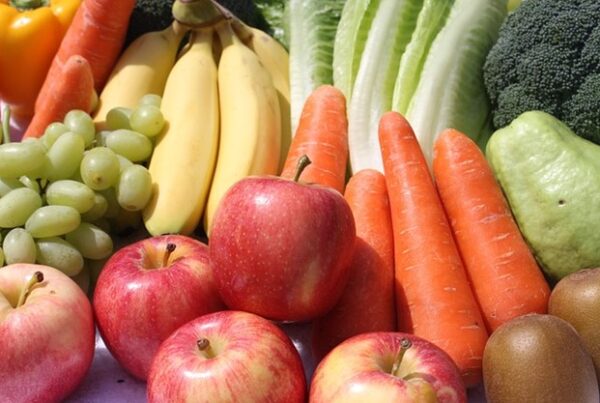
pexels-august-de-richelieu-4259140
Author: Christian Maino Vieytes, Doctoral Student, Division of Nutritional Sciences, University of Illinois at Urbana-Champaign
Optimal health derives from a complicated equation. The determinants of health are numerous, and many of them tie into the social factors that define our lives. These variables include the conditions we are born into and those that we grow up and age in (1). Unfortunately, there is still a palpable disparity in health outcomes observed between those with the most and the least resources in our society (2). These differences translate into health outcomes and life expectancy, with wealth being a direct predictor of those two results (1).
Food Insecurity
Inherent to the social factors that are predictive of health status is food security. Access to nutritious food is an integral component of health that remains a widespread issue, affecting nearly 50 million Americans who remain classified as “food insecure” (3). The United Nations defines food security as “people having at all times, physical, social and economic access to sufficient, safe and nutritious food which meets their dietary needs and food preferences for an active and healthy life” (4). The factors that predict good health, namely income status, are also intimately tied to food insecurity. Lower-income families and individuals have a higher propensity for being food insecure. Food security, itself as an issue, has been linked to higher rates of chronic diseases like cardiovascular disease (5,6). Beyond the moral and ethical dilemmas posed by rampant food insecurity; a public health crisis is also an increasingly obvious consequence.
Is there enough Food?
There is enough nutritious food produced on the planet to feed the world’s population (4). In light of this fact, the question arises: why does access to adequate quantities of nourishing food remain such a pervasive issue? The answer is complicated by an understanding of both individual-level factors (such as drug abuse, disability, or parental involvement) and systemic contributions to food insecurity (7). These include violent conflict in a society, trade structures, and government financial and food policy (8). Furthermore, history has shown us that distribution efforts and policy were the prevailing causes of historical famines, not necessarily food shortages themselves (9).
Case Study: Food Deserts
Food deserts are found in urban and very rural settings (10,11). These “deserts” are defined by a shortage of options and opportunities for access to healthy and nutritious foods. They will tend to lack supermarkets with access to fresh produce and may only have a gas station that sells packaged foods. A consequence of this lack of access is that residents of these regions tend to consume ‘empty calories’, made up primarily of processed and ‘junk’ foods, as their primary source of food intake. In effect, this helps explain the link between food insecurity, obesity, and other chronic diseases (12). Researchers who study the sources and solutions to food insecurity and food deserts provide that governments and policy are both the causes and the solutions to these issues (13).
The Government Steps In
Despite the consequences of food insecurity that continue to exist, the United States government has taken measures to alleviate the extent of this problem here at home. National programs that combat food insecurity have been developed by the federal and state governments. The United States Department of Agriculture (USDA) Supplemental Nutrition Assistance Program (SNAP) is the nation’s largest food assistance program that targets low-income Americans and provides them the means of acquiring healthful and nutritious foods. SNAP is meant to be a temporary solution for Americans struggling with food insecurity. The program serves roughly nine million Americans and functions by providing vouchers to needy participants to purchase fruits, vegetables, cereals, meats, and dairy products from authorized retailers across the country (14). The success of SNAP in lifting low-income families out of a state of food insecurity and poverty has been discussed extensively by researchers (3). This program’s growth will be crucial to addressing and minimizing the effects of the ongoing food security crisis in the United States.
Takeaways
We have analyzed the complexity that underlies income, food security, and optimal health. Food and nutrition policies and programs like SNAP are central to the fight against hunger in America. Nevertheless, several remedies to this problem remain unsolved. Many non-governmental organizations deserve recognition as these organizations work tirelessly to develop solutions to this issue. These include Feeding America and the hundreds of food banks and pantries across the country they partner closely with and support. Solving the food security crisis in the United States may require massive action coming from local, state, and the federal government.
What can you do about ending hunger?
If you are interested in contributing to ending hunger in America, I would recommend becoming connected with the local food bank or pantry in your area to ask about volunteering opportunities and donations. As a volunteer myself, I can personally attest to the significance of the contributions made by these entities and the support they deserve from their local communities.
References
- Marmot M, Bell R. Fair society, healthy lives. Public Health. 2012 Sep;126:S4–10.
- Marmot M, Friel S, Bell R, Houweling TA, Taylor S. Closing the gap in a generation: health equity through action on the social determinants of health. The Lancet. 2008 Nov;372(9650):1661–9.
- Gundersen C. Food Insecurity Is an Ongoing National Concern. Adv Nutr. 2013 Jan 1;4(1):36–41.
- Position of the American Dietetic Association: Addressing world hunger, malnutrition, and food insecurity. J Am Diet Assoc. 2003 Aug;103(8):1046–57.
- Seligman HK, Laraia BA, Kushel MB. Food Insecurity Is Associated with Chronic Disease among Low-Income NHANES Participants. J Nutr. 2010 Feb 1;140(2):304–10.
- Laraia BA. Food Insecurity and Chronic Disease. Adv Nutr. 2013 Mar 1;4(2):203–12.
- Gundersen C, Ziliak JP. Childhood Food Insecurity in the U.S.: Trends, Causes, and Policy Options. Future Child. 2014;24(2):1–19.
- Messer E, Cohen MJ. Conflict, Food Insecurity and Globalization. Food Cult Soc. 2007 Jul;10(2):297–315.
- Swift J. Understanding And Preventing Famine and Famine Mortality. IDS Bull. 1993 Oct;24(4):1–16.
- Smith C, Morton LW. Rural Food Deserts: Low-income Perspectives on Food Access in Minnesota and Iowa. J Nutr Educ Behav. 2009 May;41(3):176–87.
- Mead MN. Urban Issues: The Sprawl of Food Deserts. Environ Health Perspect. 2008 Aug;116(8):a.
- Walker RE, Keane CR, Burke JG. Disparities and access to healthy food in the United States: A review of food deserts literature. Health Place. 2010 Sep;16(5):876–84.
- Segal AY. Food Deserts: A Global Crisis in New York City. 2010 [cited 2020 Oct 15]; Available from: https://academiccommons.columbia.edu/doi/10.7916/D8PG1RCG
- Wilde PE. The New Normal: The Supplemental Nutrition Assistance Program (SNAP). Am J Agric Econ. 2013 Jan;95(2):325–31.




![Blog Post Image: Pexels [Silhouette Photo of Jumping Children, photo by Margaret Weir, Sept. 22, 2017, CC0]](https://oneop.org/wp-content/uploads/2024/04/pexels-margaret-weir-620530-600x403.jpg)










